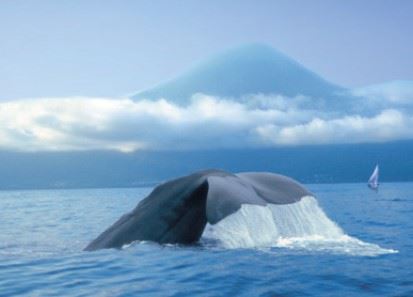Surrounded by the mild waters of the Atlantic Ocean, the Azores get more than their fair share of whale traffic passing close to the islands’ shores. Sperm whales, Pilot whales and Bottlenose Dolphins are frequent summer visitors, while the cooler months bring the Humpback whales and Blue whales towards these volcanic islands in the mid-Atlantic. For many visitors it is the chance to go whale watching which attracts them to the Azores.
So if you’re planning to head out on a trip to see whales and dolphins, what are the best tips to help you make the most of the experience?
Choose good weather
If the sea is too rough the boat trips won’t run, but if you have a choice then choose a sunny day with little wind. The trip will be far more pleasant and a calm sea will help you to watch and photograph anything you spot.
Come prepared
It’s usually cooler at sea than on land, so always pack an extra layer or two, and dress for adverse weather (it’s not unusual in the Azores to go from sun to rain and back to sun in a matter of minutes). Pack suncream and bring seasickness tablets if your unsure about your sea legs; small boats can offer a more intimate whale-watching experience than the larger vessels, but the bigger boats may provide a less choppy ride.
Brush up on your whale knowledge
Your guide will no doubt be able to identify any sightings, but for many visitors there’s an added thrill in being able to quickly distinguish one type of whale from another. A keen whale-watcher will know a breach from a spy-hop, and by anticipating a whale’s behaviour you’re better placed to capture that elusive photo. Shouting ‘There she blows!’ is a compulsory element of any first-time sighting.
Pack your camera – or don’t
Photographing any sea creature is notoriously tricky. From the time the first part of a whale breaks the surface of the water you only have a few seconds to turn and shoot. A large lens will help zoom in on any object but it’s also harder to line up your target quickly. If you’re not too serious about your photography then there’s a strong argument for leaving your camera behind altogether. Most photos taken on whale-watching trips are of empty patches of ocean where a whale has just been; avoid the frustration and immerse yourself in the magic of the experience without the barrier and the distraction of the camera. There are plenty of fabulous whale photos on sale in the harbour shops.
Remember that animals have their own schedule
At the right time of the year, in the right conditions and in the right place, a whale sighting is almost guaranteed. Almost. You may get multiple sighting on a single trip, and you may get none. That’s the way that whale-watching (and almost any wildlife experience) works, and that’s what makes those sightings so special. Soak up the whole experience of being at sea, of enjoying the camaraderie on board and of the views across the shore, and treat any sighting as the special bonus it is.



